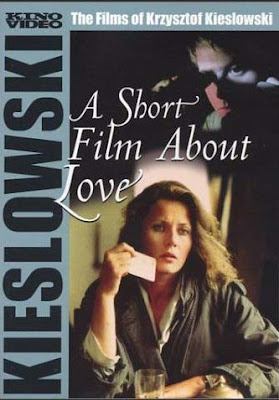 "Scarlet Street" *** (out of ****)
"Scarlet Street" *** (out of ****) Not too long ago I reviewed the Fritz Lang film "The Woman in the Window" (1944). Well, if you happened to take my advice and rented that movie and you liked it, I've got another treat for you. "Scarlet Street" (1945) was Fritz Lang and Edward G. Robinson's next film.
"Scarlet Street" and "The Woman in The Window" have many things in common. They both deal with very similar ideas and have much of the same cast.
Normally, I feel when reviewing a movie you should always review the film on its own merits and not compare to other films. But, in the case of "Scarlet Street" I think the comparisons are appropriate. These are two very interesting films that are about much more than what is on the surface. The films belong hand and hand. If you haven't taken my advice yet and watched "The Woman and the Window", please do yourself a favor and watch both of these films back to back.
In "Scarlet Street" Robinson once again plays a middle-aged man. This time Chris Cross, who is celebrating 25 years of working at a bank as a cashier. His real passion however is painting. When we first meet Chris he is reflecting upon his old age and wonders about younger women. He wonders what it would be like to have a young beautiful woman love you. What kind of things does that do to a man?
After the party, while walking home, he notices a young woman getting beat up by a man. He slaps her around, and when she falls down he starts kicking her. I can't think of too many movies where this sort of brutality was shown against women. Chris runs to the young woman's defense and hits the man with his umbrella. When Chris notices the man is not moving, he runs for the police. When he does, the man gets up as the woman tells him to beat it. It would appear they know each other.
The woman is Kitty March (Joan Bennett, who was the woman in the window) and the man was her boyfriend/pimp Johnny (Dan Duryea, also in "The Woman in the Window", playing a similar sleazeball kind of character). Chris is immediately taken in by Kitty's beauty. She looks at him as a weird older man. In an attempt to impress Kitty, Chris pretends he is an artist, and doing quite well. He lets her think he is a big name in Europe where his paintings sell for hundreds of dollars.
Eventually we find out why Johnny was hitting Kitty. Johnny is a gambler and a drunk. He wanted some money but when Kitty didn't have it, he felt he had to teach her a lesson. Since they are hard up for cash, Johnny has an idea for the perfect scheme. Chris is clearly in love with Kitty, and since he is so wealthy, why not let him take care of her. And so the two con Chris into buying Kitty a studio apartment and always helping her out financially whenever she needs it.
What Kitty doesn't know is that Chris is married to Adele (Rosalind Ivan). It is a loveless marriage. She is a nagging brute. It is her second marriage. She even keeps a giant photo of her husband in their living room and constantly compares Chris to her departed first husband.
These scenes are crucial to the film because they set up the underlying themes of the movie. In this marriage Adele is head of the household. It is Chris who cleans the house and does the dishes. When he does do the dishes he even wears an apron. That in itself is not bad, but, he wears a flower apron. When a friend stops by Chris must watch his "p's" and "q's". He must make sure not to disturb his wife. He has no freedom in his own home.
And that leads to what both "Scarlet Street" and "The Woman in the Window" are really about. In both films Robinson must prove himself as a man. These films are about masculinity. In "Scarlet Street" he has lost it and must prove to others and himself that he is in fact a man. Both of these films have more in common with F.W. Murnau's "The Last Laugh" (1924), a film about the downfall of a man who loses his dignity, than other noir films such as "The Postman Always Rings Twice" (1946) or "This Gun For Hire" (1942).
Yes the usual elements of noir are here; lust, women, money, power, double-crossing. But those are just a pretext to tells us the story of the emasculation of Chris.
If you read my review for "The Woman in the Window" you'll know I said I enjoyed the film a great deal except for the ending, which I felt was a cop out and rumor has it, Lang didn't want that ending either, but, was forced to add it on by the Hollywood censorship board. "Scarlet Street" doesn't have that problem. This is a much darker film with a disturbing ending. The film doesn't pull back. In fact, in certain ways, it was ahead of its time. It was banned in some cities.
First of all, the whole aspect that Chris is married yet is seen flirting with and kissing Kitty was against the production code. Even though Adele and Chris are not in love. Also, it is one of the few films I can think of where an "innocent" man dies. And its "punishment" is drastically different than the retribution most criminals get in other films. But, I can't comment on these things without spoiling the film.
The only thing I don't like about the movie is the lighting. It is not a dark movie. It is pretty brightly lit. It doesn't have a true noir feel to it. Though as I said, many of the ingredients are here. It is darker in its story and its treatment of characters but I thought Lang should have been making more use of shadows and darkness.
The film was based on a Georges de la Fouchardiere novel entitled "La Chienne" and adapted by Dudley Nichols. A rather strange choice in my opinion. He wrote the Rene Clair comedy "It Happened Tomorrow" (1944), which I reviewed on here and the classic screwball comedy, Howard Hawks' "Bringing Up Baby" (1938). "Scarlet Street" is a very different film in tone.
While I may not like this movie as much as I do other Fritz Lang titles; "Fury" (1936) or "M" (1931), I have to admit this is an entertaining picture with interesting social ideas. And you have to give credit to Edward G. Robinson. These two roles; "Woman" and "Scarlet" are just opposites of the roles that made him famous. If you are not familiar with Robinson, he use to play tough guys. To see him in roles like this is all the proof one needs that he was truly a gifted actor. I think his performance here is stronger than in "The Woman in the Window". And I think Joan Bennett is much more sexier here.
"Scarlet Street" is a sharp, well written, wonderfully acted film. This is not your typical noir film. Please watch this back to back with "The Woman in the Window". I think film buffs or younger movie fans will be impressed.




















